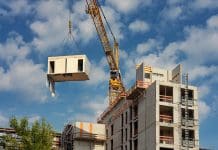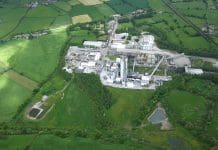There is a need for Building Regulations to extend beyond operational carbon assessments to include embodied carbon if the UK is to meet its net zero commitments. Anastasia Mylona, technical director at CIBSE, explains how this could be approached
One quarter of the UK’s total greenhouse emissions are attributable to the built environment.
Greenhouse gases are emitted at every stage of a building’s lifecycle, from the manufacture of materials, through construction, operation and maintenance to eventual demolition.
If the UK is to meet its net zero targets by 2050, emissions from the built environment must be reduced. To date, policy and regulation has focused entirely on operational emissions – those emissions resulting from energy consumed in the day-to-day running of a building.
In contrast, all other emissions – those resulting from the manufacture of materials, the construction process, maintenance and demolition of buildings – have been ignored.
Emissions resulting from materials manufacturing need to be reduced
Collectively described as embodied carbon, these emissions are estimated to total up to 50m tonnes of CO2 annually, more than the annual emissions from aviation and shipping combined.
Totalling the figures for both operational and embodied carbon over the lifespan of a building gives a figure for its Whole Life Carbon (WLC). It is this WLC figure that needs to be used when assessing the UK’s progress to net zero emissions.
It would, after all, be counterproductive to construct an energy efficient building with minimal operational emissions if the carbon embodied in the materials and processes used in its construction far outweighed any savings in operational carbon within the building’s expected lifespan.
The WLC issue was brought into sharp focus earlier this year in a high-profile debate over the relative sustainability of replacing or repurposing some of the capital’s landmark buildings.
This resulted in the London Assembly Planning & Regeneration Committee publishing a report calling for Whole Life Carbon assessments to be part of planning applications.
Internationally, some European countries and states in the USA have already introduced whole-life carbon and embodied carbon rules. Since 2012, for example, the Netherlands has required new residential and office buildings larger than 100m2 to have whole-life carbon mitigation cost estimates using a national methodology.
In the UK, professional institutions such as CIBSE supported by the broader construction industry have proposed amending the Building Regulations to include a new section known as Approved Document Z to mandate reporting of whole-life carbon on all building projects over 1,000m2.
This is important because it is estimated that embodied carbon accounts for between 30% and 70% of the whole-life carbon emissions from a building.
Challenges of embodied carbon reporting
CIBSE recognises that the introduction of mandatory embodied carbon reporting will not be without its challenges, not least because of the lack of information around the embodied carbon of some complex building products.
Where they exist, Environmental Product Declarations (EPDs) provide a robust means of detailing the carbon emissions associated with every stage of the lifecycle of the product.
The problem with relying on EPDs for embodied carbon accounting is that they generally only exist for simple building products. It is relatively straightforward to produce a declaration for a product such as a brick or a plasterboard panel, where the number of base materials used in manufacture is limited and their origins completely understood.
However, EPDs generally do not exist for complex items of mechanical plant, such as an air conditioning unit or a heat pump, because it is far harder to produce an EPD for an item assembled from numerous components and assemblies that are often sourced from around the world.
As a consequence, a lot of building services plant and equipment is yet to be EPD accredited.
Engineers need a clear understanding of the carbon embodied in materials
As a professional institution, CIBSE is focused on the design and application of building services, including heating, lighting, ventilation and air conditioning to provide a safe and healthy built environment in which people can live and work.
Without a clear understanding of the carbon embodied in the materials and components that make up these systems, it is impossible for engineers to calculate the WLC associated with the building services, and hence the difficulty in determining the WLC for a particular building.
A new calculation method developed by CIBSE
Knowing this, CIBSE has developed a calculation method to allow engineers to evaluate the embodied carbon of complex building products.
Published as Technical Memoranda 65 (TM65) Embodied Carbon in Building Services: A Calculation Methodology, the document provides guidance on how to use EPDs to assess the embodied carbon of building services equipment; and where EPDs are not available, it provides guidance on how to estimate the embodied carbon in complex items of plant.
Importantly, TM65 does not aim to replace EPDs, indeed it cannot, but rather it allows initial embodied carbon estimations to be made while waiting for EPDs to become available.
As momentum into reporting building whole-life carbon for buildings gathers pace around the globe, to remain competitive more and more manufacturers will have to produce EPDs for their products.
Until then, CIBSE’s TM65 is there to help the building services sector – manufacturers, designers and installers – to take a first step in evaluating the carbon emissions embodied in building services systems.
Building Regulations should set requirements for embodied carbon
Despite the challenge of producing EPDs for building services products, CIBSE fully supports a future where Building Regulations set requirements for embodied carbon in the same way that Part L currently sets performance standards for thermal efficiency and Part F for ventilation.
Without this step, it will be impossible to substantiate any claim that a building is net zero carbon.
It is CIBSE’s view that the failure to incorporate embodied carbon into the proposed Future Homes Standard was a glaring omission.
CIBSE has supported the proposed introduction of Part Z since its inception and would encourage the government to come forward with new proposals as soon as possible.
We hope that sustained pressure from all areas within the built environment will ensure that embodied carbon will ultimately be incorporated into the Building Regulations so that we will have the knowledge to construct genuinely net zero carbon buildings.














